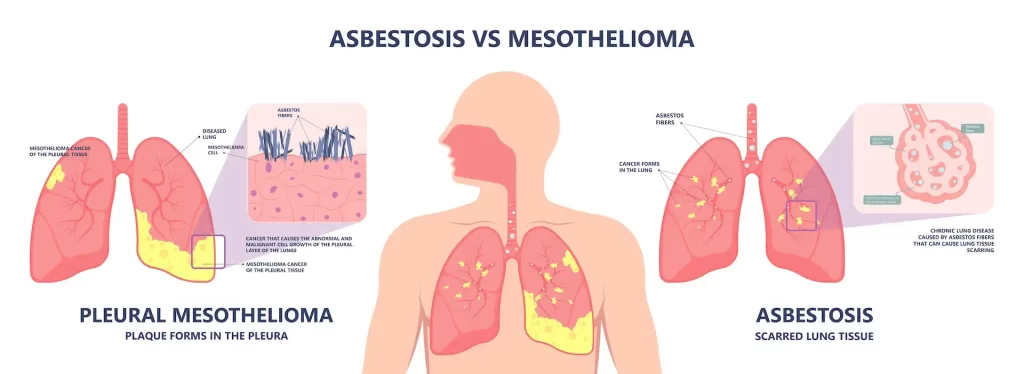Lung Cancer And Mesothelioma: Similarities, Differences, And The Way Forward
They both affect the lungs. Both are caused by asbestos exposure. But lung cancer and mesothelioma have several distinctions that victims and their families should know about — something the attorneys at Serling & Abramson, P.C. understand thoroughly. We are experts in all asbestos-related illnesses, having handled thousands of cases for residents right here in Michigan.
Lung Cancer: Key Characteristics
Exposure to carcinogens (including cigarette smoking) is the leading cause of lung cancer. Lung cancer is also caused by exposure to asbestos, a naturally occurring carcinogenic mineral that has been used by many industries and in many products. When inhaled, asbestos fibers lodge in the lung tissue and, over time, may contribute to the development of lung cancer.
The likelihood of developing lung cancer after asbestos exposure is substantially increased in individuals who have smoked. While a person can develop lung cancer following asbestos exposure even if that person has no other risk factors, asbestos exposure in conjunction with cigarette smoking significantly increases the risk of developing lung cancer.
Studies have shown that individuals who both smoked and have been exposed to asbestos are 50-90 times more likely to develop lung cancer than a person who neither smoked nor was exposed to asbestos. Cigarette smokers who have been exposed to asbestos and develop lung cancer are still entitled to compensation for their damages.
Common lung cancer symptoms include:
- Shortness of breath
- A cough that won’t go away (or gets worse)
- Coughing up blood
- Chest pain
- Hoarseness
- Loss of appetite
- Unexplained weight loss
- Feeling tired or weak
- Infections that won’t go away or keep coming back (such as bronchitis or pneumonia)
- Wheezing
Note: Victims of asbestos-related lung cancer often suffer from non-cancerous asbestosis (non-malignant scarring of the lungs caused by the inhalation of asbestos fibers) before their lung cancer develops — in some cases 20 or more years after the initial exposure.
Mesothelioma: Key Characteristics
Mesothelioma is a rare and very aggressive form of cancer that forms on the mesothelium, the protective lining covering the lungs, abdomen, and other organs. Scientists agree that the only known cause of mesothelioma is asbestos exposure. This typically occurs in a workplace setting where asbestos has been used as insulation, a flame retardant, in cement, or other applications. Smoking does not cause mesothelioma.
Pleural mesothelioma (mesothelioma of the lungs) closely resembles lung cancer. However, it forms in the protective membrane between the lungs and chest wall.
Common mesothelioma symptoms include:
- Shortness of breath
- A build-up of fluid in the lungs or abdomen
- Pleural effusion
- Unusual weight loss
- Chest pain, especially after exertion
- Bowel obstruction
- Abdominal pain
- Painful coughing
- Unusual lumps of tissue under the skin on your chest or abdomen
Mesothelioma can also take a long time to develop — usually between 20 and 50 years from the first asbestos exposure to diagnosis. Unlike lung cancer caused by smoking, the risk of mesothelioma does not reduce over time after the exposure stops.
Detecting Lung Cancer Vs. Mesothelioma
If lung cancer is suspected, X-rays followed by a lung biopsy are usually used to confirm a doctor’s diagnosis. If a pathologist examines a tissue or fluid sample and confirms it is lung cancer, their pathology report is crucial to supporting a compensation claim.
Detecting mesothelioma is more difficult and can involve advanced imaging techniques such as an MRI or CAT scan, with a biopsy to follow. If you are undergoing testing for mesothelioma, it is important to let your doctors know if you or a family member worked near asbestos for a living. This helps them determine whether past asbestos contact could have led to a current disease.
Crucial Next Steps After A Diagnosis
Receiving a lung cancer or mesothelioma diagnosis is the beginning of a difficult, emotional time. Besides concerns about upcoming treatment plans and recovery, there are insurance issues and medical costs to deal with. It is important to keep all medical and insurance documents during this period.
Suppose you or a family member have been exposed to asbestos at work or from other asbestos-containing products and have now been diagnosed with lung cancer or mesothelioma. In that case, you have legal options to consider. Start by scheduling a free legal consultation with a lawyer at our firm.
An Advantage That Can Make All The Difference
By choosing a local firm like Serling & Abramson, P.C., you’re getting the advantage of working with attorneys who have expert knowledge about litigating asbestos cases in Michigan.
Importantly, the state of Michigan allows individuals who receive a settlement for asbestosis to file a “second disease” case if they are diagnosed with primary lung cancer or mesothelioma later — even decades later. Even if your asbestosis case was handled by another firm, Serling & Abramson, P.C. is an experienced choice for your “second disease” cancer case.
Time Is Of The Essence
Like most states in the U.S., Michigan has a time limit for the filing of a lung cancer or mesothelioma case. Serling & Abramson, P.C. can make sure you don’t waste a minute.
The differences between lung cancer and mesothelioma are important in the law. But the victims of both afflictions matter equally to our lawyers. Let Serling & Abramson, P.C. put our 50+ years of handling asbestos-related cases to work on your behalf.





